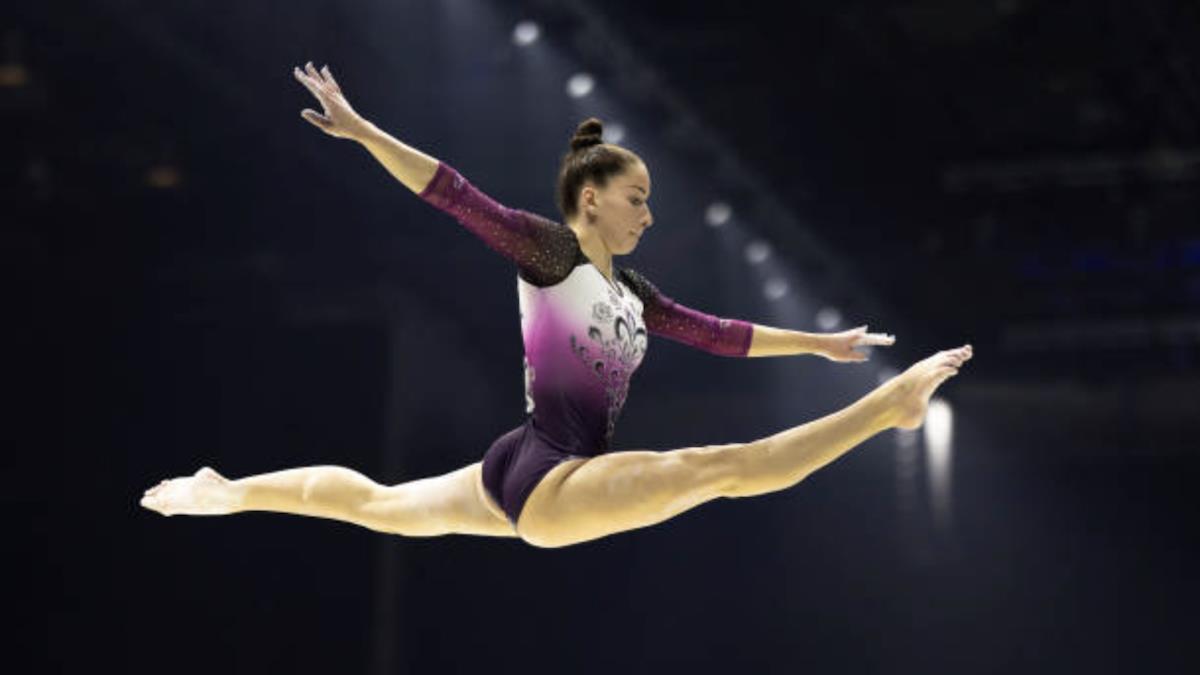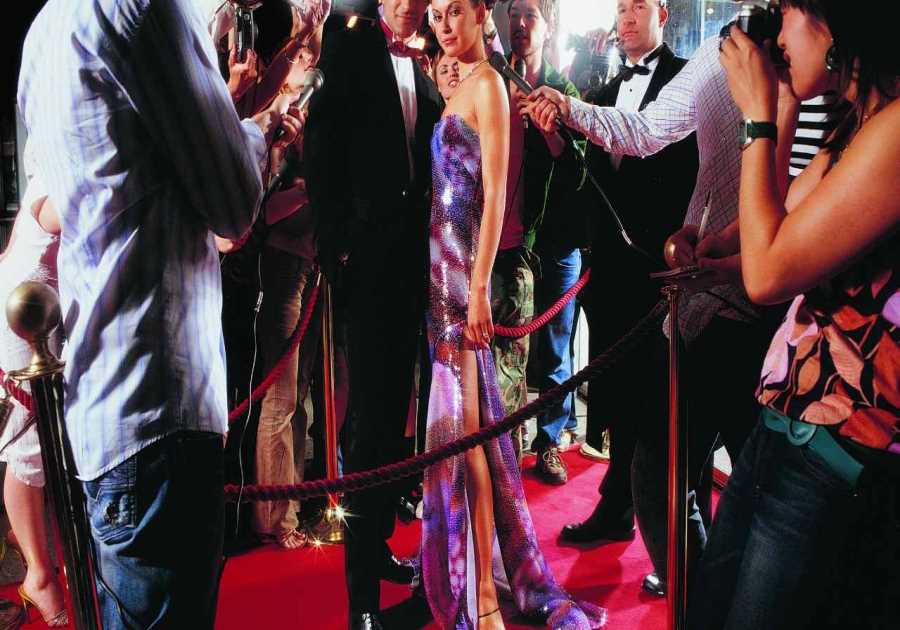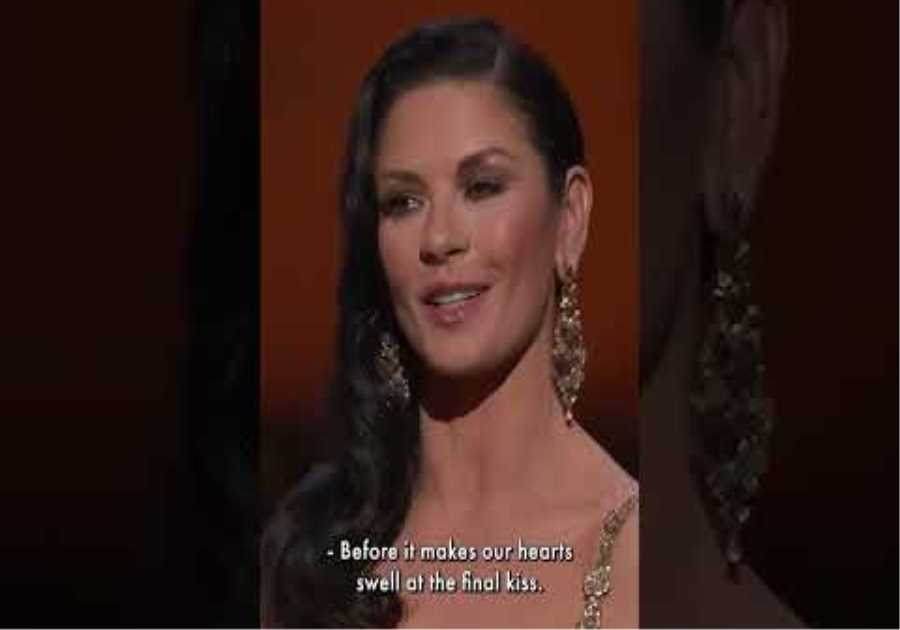
Zsofia Kovacs
This year’s world championships is the number one qualifying meet for the Paris 2024 Olympic Games. A total of 9 teams will qualify for both WAG and MAG, in addition to 21 individual WAG athletes and 18 individual MAG athletes, constituting the vast majority of the available Olympic spots.
Because the process can be a bit daunting to figure out, we’re going to talk through all of it here, including who has already qualified, who will qualify in Antwerp, and how athletes who don’t qualify here will have a couple of additional chances next spring, and we’ll also share a case study using the results from last year’s competition in Liverpool so you can see exactly how things would look using tangible data.
If you’re a bit more adventurous and want to take a look at the rules yourself, you can find them in the FIG’s Qualification System document.
Who Has Already Qualified?
So far, there has only been one qualifying event for the Olympics – last year’s world championships.
For both WAG and MAG, the 3 top-ranked teams based on the team final results earned team berths, which allows for 5 athletes per NOC (otherwise known as National Olympic Committee, which is the language often used in place of words like team, nation, or federation in these cases). The teams to qualify in 2022 included:
| WAG | ||
| United States | Great Britain | Canada |
| MAG | ||
| China | Japan | Great Britain |
These teams could finish dead last in Antwerp or skip worlds completely – they have nothing more to do and are safe and sound for 2024.
How Do Teams Qualify in Antwerp?
The 9 highest-ranked NOCs not already qualified to the Olympics will earn team berths in Antwerp, with these rankings based on the team qualification results for both WAG and MAG – so basically any team that finishes in the top 12 that isn’t one listed above in each discipline. As with the NOCs that qualified in Liverpool, each team berth allows for 5 athletes per NOC.
How Do Individuals Qualify in Antwerp?
There are three routes for individual qualifiers at worlds, which I’ll break down as succinctly as I can:
- The 3 highest-ranked NOCs that didn’t qualify a team (so, the teams ranked 13th, 14th, and 15th essentially) will each earn 1 individual athlete berth for their NOC (meaning the spot is non-nominative, belonging to the NOC and not to any individual athlete)
- The 14 highest-ranked eligible WAG athletes and the 8 highest-ranked eligible MAG athletes based on the all-around qualification results will earn individual berths (these spots are nominative, meaning the athletes who earn these spots own them, and there is a maximum of 1 spot per NOC)
- The highest-ranked eligible athlete on each apparatus based first on apparatus final results and then, if needed, on apparatus qualification results will earn individual berths (these spots are nominative, meaning the athletes who earn these spots own them; additionally, athletes who qualify on an apparatus are eligible to compete all events at the Olympic Games)
“Eligible” in the above language just means that the athlete can’t be from an NOC that has qualified a team either in 2022 or 2023, and for the apparatus spots, can’t have qualified through the all-around. Basically, the all-around qualifiers will be determined first, and then the apparatus qualifiers are next in line.
- For example, if South Korea doesn’t qualify a team but Yeo Seojeong finishes among the top 14 all-arounders and also wins vault, she will qualify through the all-around criteria, and the vault spot will go to the next eligible athlete.
While the nominative all-around spots only allow for 1 athlete per NOC, an NOC can qualify multiple individuals to Paris if they fit that first criteria (finishing 13th, 14th, or 15th in team qualifications) and also earn nominative spots, which brings me to the next rule you should know!
In addition to the nominative all-around berths being limited to 1 per country, the maximum number of athletes an NOC can qualify individually across all three paths is 3. That could be one nominative all-arounder and two nominative apparatus qualifiers; three apparatus qualifiers; one non-nominative all-arounder, one nominative all-arounder, and one apparatus qualifier…the possibilities are endless! But not really, because again, they’re limited to 3.
This is really where things are the most confusing, but I’m hoping the case study will clear up most of that.
What’s Left?
At the conclusion of this year’s worlds, all team spots will have been taken, but an additional 13 WAG athletes and 17 MAG athletes have the opportunity to qualify in 2024 via the apparatus world cup series and the continental championships.
We’ll talk more about both of these after worlds, but for now, here’s a little intro into how both will work.
The Apparatus World Cup Series
The first way athletes can qualify next year is through the apparatus world cup series. At the conclusion of the series next spring, the two highest-ranked eligible athletes will earn nominative berths, with the series rankings based on a points system that accounts for the best three out of four competitions for each athlete. A total of 8 WAG athletes and 12 MAG athletes will qualify this way.
Again, “eligible” here means that athletes can’t be part of NOCs that have qualified teams and also of course can’t have previously qualified as individuals. There is only 1 spot available per NOC, and the eligibility requirements also refer back to that 3-per-country rule for the individual spots at worlds. If an NOC has already qualified 3 spots through worlds, they are not eligible to earn additional spots next year.
The Continental Championships
Finally, the continental championships, which might be the most straightforward way an individual can qualify, with a total of 5 WAG athletes and 5 MAG athletes earning berths across all 5 continental championship meets (in other words, 1 WAG athlete and 1 MAG athlete per continental meet).
The highest-ranked eligible athlete from either the all-around qualification or final results (this is up to each respective continental governing body) will earn a nominative berth to Paris, with “eligible” again meaning everything stated above in terms of not previously qualifying via team or other individual means, and your NOC can’t have already qualified 3 individual athletes.
Here’s a Chart!
Too long, didn’t read? Here’s a chart with the numbers and most basic rules.
| Qualifier | WAG Berths | MAG Berths | Rules |
| 2022 World Championships (Teams) | 3 teams (15 athletes) |
3 teams (15 athletes) |
The highest-ranked eligible NOCs based on the team final results |
| 2023 World Championships (Teams) | 9 teams (45 athletes) |
9 teams (45 athletes) | The highest-ranked eligible NOCs based on the team qualification results |
| 2023 World Championships (NOC Individual) | 3 athletes | 3 athletes | The highest-ranked eligible NOCs will obtain 1 individual non-nominative athlete berth (non-nominative) |
| 2023 World Championships (All-Around) | 14 athletes | 8 athletes | The highest-ranked eligible athletes based on all-around qualification results (nominative) |
| 2023 World Championships (Apparatus) | 4 athletes | 6 athletes | The highest-ranked eligible athlete on each apparatus, based first on the apparatus finals results and then, if needed, on the apparatus qualification results (nominative) |
| 2024 Apparatus World Cup Series | 8 athletes | 12 athletes | The two highest-ranked eligible athletes per apparatus based on the world cup series ranking list (nominative) |
| 2024 Continental Championships | 5 athletes | 5 athletes | The highest-ranked eligible athlete based on either the all-around qualifications results or the all-around final results at the discretion of the respective continental governing body (nominative) |
The Case Studies
If you haven’t memorized every rule or piece of criteria or number, don’t worry! It’s so much easier to see how these things play out using real-life scenarios, so that’s why we’re doing case studies!
Note that we’re only doing case studies for this year’s worlds, not for last year’s worlds (since they already happened and the teams that made it are listed above!) the world cups or continental championships, and we’re using last year’s results for both WAG and MAG If you’d like to click through and see how we’re coming up with everything.
Without further ado, let’s start with WAG.
| TEAM QUALIFIERS – 9 NOCs | |
| Brazil | Italy |
| Japan | China |
| France | Netherlands |
| Australia | Belgium |
| Germany | |
I think this is fairly straightforward – if we pretend these are the rankings for this year, it’s the 9 teams that finished in the top 12 in qualifications, exclusive of the 3 teams that already secured spots from last year’s team final (United States, Great Britain, and Canada as a refresher).
| NOC INDIVIDUAL QUALIFIERS – 3 NOCs | |
| South Korea | Hungary |
| Mexico | |
These are the teams that finished 13th, 14th, and 15th in qualifications, so each country gets one individual spot they can use however they’d like.
| ALL-AROUND QUALIFIERS – 14 ATHLETES | |
| Ana Barbosu (Romania) | Laura Casabuena (Spain) |
| Lee Yunseo (South Korea) | Maisa Kuusikko (Finland) |
| Natalia Escalera (Mexico) | Camille Rasmussen (Denmark) |
| Lucija Hribar (Slovenia) | Greta Mayer (Hungary) |
| Lihie Raz (Israel) | Nathalie Westlund (Sweden) |
| Rocio Saucedo (Argentina) | Selina Kickinger (Austria) |
| Aneta Holasova (Czechia) | Caitlin Rooskrantz (South Africa) |
These are the top 14 individual all-around athletes from qualifications who are not part of teams that qualified. Notice that South Korea, Hungary, and Mexico all qualified non-nominative individual spots in the previous example, and then they all also qualified nominative all-around spots here, meaning they’ve already earned two spots apiece.
This list also accounts for the 1-per-country rule. For example, Ada Hautala (Finland) actually finished 37th in all-around qualifications, directly between Hribar (36th) and Mayer (38th), but because Kuusikko finished ahead of Hautala in 29th place, Kuusiko would get a spot and Hautala would not.
| APPARATUS QUALIFIERS – 4 ATHLETES | |
| VT: Yeo Seojeong (South Korea), vault | UB: Ahtziri Sandoval (Mexico) |
| BB: Zsofia Kovacs (Hungary), beam | FX: Jasmin Mader (Austria) |
No eligible athletes qualified into the bars or floor apparatus finals, so we had to dig into the qualification results here to find the top eligible athletes.
With South Korea, Mexico, or Hungary earning non-nominative individual spots, nominative all-around spots, and now also nominative apparatus spots as Yeo finished 7th on vault and Kovacs finished 7th on beam in the apparatus finals and Sandoval finished 29th in bars qualifications, it means all three NOCs have officially filled all three of their available berths and are not eligible for any world cup or continental spots.
Meanwhile, Austria qualifying Mader on floor in 36th place means they’ve earned two out of three spots after Selina Kickinger qualified through the all-around, making Austria the only NOC aside from South Korea, Hungary, and Mexico to pick up more than one individual berth at worlds.
Something of note here was Zoja Szekely coming in as the top non-qualified bars athlete in 22nd place, but because Hungary had previously qualified three spots – with Kovacs’ apparatus final vault ranking taking precedent over Szekely’s bars ranking – she would not be eligible for a spot. However, the federation could name her to its non-nominative spot, so not all hope is lost!
So, that’s it for WAG! Any questions? Ask below! Now let’s move on to MAG.
| TEAM QUALIFIERS – 9 NOCs | |
| United States | Italy |
| Spain | Brazil |
| South Korea | Germany |
| Canada | Türkiye |
| Hungary | |
Again, straightforward, as these are the 9 teams that finished in the top 12 in qualifications, exclusive of the three teams that secured spots from last year’s team final (China, Japan, and Great Britain as a refresher).
| NOC INDIVIDUAL QUALIFIERS – 3 NOCs | |
| Netherlands | France |
| Egypt | |
Just as with WAG, these are the teams that finished 13th, 14th, and 15th in qualifications, so each country gets one individual spot they can use however they’d like.
| ALL-AROUND QUALIFIERS – 8 ATHLETES | |
| Carlos Yulo (Philippines) | Casimir Schmidt (Netherlands) |
| Illia Kovtun (Ukraine) | Tang Chia-Hung (Taiwan) |
| Sofus Heggemsnes (Norway) | Jossimar Calvo (Colombia) |
| Luka van den Keybus (Belgium) | Gabriel Burtanete (Romania) |
Since MAG has a greater number of apparatus spots between worlds and the world cup series simply due to having a greater number of apparatuses, they get fewer all-around spots.
After this stage, the Netherlands has qualified two individual spots between the non-nominative and nominative berths, while every other NOC has only qualified one each.
| APPARATUS QUALIFIERS – 6 ATHLETES | |
| FX: Benjamin Osberger (France) | PH: Rhys McClenaghan (Ireland) |
| SR: Artur Avetisyan (Armenia) | VT: Artur Davtyan (Armenia) |
| PB: Marios Georgiou (Cyprus) | HB: Ilias Georgiou (Cyprus) |
Nearly all of the qualifiers here came from apparatus final standings, with the exception of parallel bars, which had no eligible athletes in the final, so we had to dip into the qualification standings to find Georgiou in 14th place.
After this final stage, there are four NOCs that have qualified more than one athlete – the Netherlands with the non-nominative and nominative all-around berths, France with a non-nominative individual berth and Osberger’s spot on floor, and both Armenia and Cyprus with two apparatus spots apiece. Since no NOCs qualified three individuals here, all NOCs that did not qualify teams would be eligible to qualify additional athletes via the world cups and continental championships.
That wraps us up here! Again, if you have any questions, please drop them below. Happy Olympic qualifying season!
Article by Lauren Hopkins
-----------------------
By: Lauren
Title: How Does Worlds Work for Olympic Qualification? A Case Study
Sourced From: thegymter.net/2023/09/22/how-does-worlds-work-for-olympic-qualification-a-case-study/
Published Date: Fri, 22 Sep 2023 16:42:14 +0000






